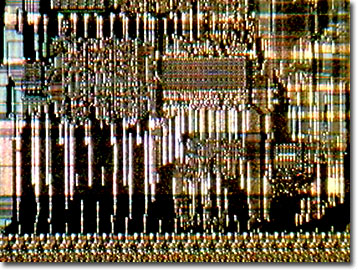Integrated Circuit Image Gallery
Intel 386 Microprocessor
In 1985, with a 16-billion-dollar software library focused on the 8088 and 80286, the compatible 80386 ushered in the third generation of Intel microprocessors. After the correction of many of the 286's inherent problems, the 386 represented a giant leap in raw power with true 32-bit architecture (external data buses and internal registers).

View a second image of the Intel 386.
View a third image of the Intel 386.
The new 386 design, available at 12.5 MHz and 16 MHz clock speeds, allowed the chip to process information more than twice as fast as the 286, and spawned a new revolution in software design. Intel increased the clock speed to 33 MHz by 1989 and ultimately, clone manufacturer Advanced Micro Devices (AMD) raised it to 40 MHz. The 386 central processing unit (CPU) was originally fabricated at the same 1.5-micron linewidth process level as the 286, but the number of transistors was more than doubled to 275,000. At a transistor number a hundred times as great as the original 4004 chip, the semiconductor manufacturers applied the new high-speed, and low-power consumption high-density complementary metal oxide semiconductor (CMOS) 1-micron technology. The best-selling 386 was the first processor for the personal computer that was able to switch between real and enhanced modes without rebooting.
The i80386 featured several processor modes to preserve backward compatibility with the 80286, and an additional memory management unit (MMU) that allowed paged memory, security rings of privilege, and new operation codes similar to those available with the Zilog Z-80 and Z-280 processors. Capable of true multi-tasking, the innovative 386 could run multiple programs simultaneously by operating in "virtual 8086 mode". In this mode, the CPU is divided into partitions, each of which functions as a separate 8086-based computer. The 80386DX is the new name given to the original 386 CPU after the release of the 80386SX, a scaled down version of the best-selling silicon chip.
Contributing Authors
Omar Alvarado, Thomas J. Fellers and Michael W. Davidson - National High Magnetic Field Laboratory, 1800 East Paul Dirac Dr., The Florida State University, Tallahassee, Florida, 32310.
BACK TO THE INTEGRATED CIRCUIT IMAGE GALLERY
BACK TO THE DIGITAL IMAGE GALLERIES
Questions or comments? Send us an email.
© 1995-2025 by Michael W. Davidson and The Florida State University. All Rights Reserved. No images, graphics, software, scripts, or applets may be reproduced or used in any manner without permission from the copyright holders. Use of this website means you agree to all of the Legal Terms and Conditions set forth by the owners.
This website is maintained by our
Graphics & Web Programming Team
in collaboration with Optical Microscopy at the
National High Magnetic Field Laboratory.
Last Modification Friday, Nov 13, 2015 at 01:19 PM
Access Count Since September 17, 2002: 9022
Visit the website of our partner in introductory microscopy education:
|
|
